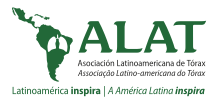Consenso argentino screening de cáncer de pulmón | Argentine consensus recommendations for lung cancer screening programmes: a RAND/UCLA-modified Delphi study
06-02-2023
6 de February de 2023
El Departamento de Oncología ALAT tiene el agrado de compartir esta nueva publicación de la que son parte destacados colegas que integran nuestro grupo.
Argentine consensus recommendations for lung cancer screening programmes: a RAND/UCLA-modified Delphi study
Iris Boyeras,1 Javier Roberti,2,3 Mariana Seijo,2 Verónica Suárez,4 José Luis Morero,5 Ana Karina Patané,6 Diego Kaen,7 Sebastián Lamot,8 Mónica Castro,1 Ricardo Re,9 Artemio García,10,11 Patricia Vujacich,12 Alejandro Videla,13 Gonzalo Recondo,9 Alfonso Fernández-Pazos,14 Gustavo Lyons,11 Hugo Paladini,15 Sergio Benítez,16 Claudio Martín,5,6 Sebastián Defranchi,17 Lisandro Paganini,5 Silvia Quadrelli,11,18 Sebastián Rossini,19 Ezequiel Garcia Elorrio,2 Edgardo Sobrino20
ABSTRACT
Background. Lung cancer (LC) screening improves LC survival; the best screening method in terms of improving survival is low-dose CT (LDCT), outpacing chest X-ray and sputum cytology.
Methods. A consensus of experts in Argentina was carried out to review the literature and generate recommendations for LC screening programmes. A mixed-method study was used with three phases: (1) review of the literature; (2) modified Delphi consensus panel; and (3) development of the recommendations. The Evidence to Decision (EtD) framework was used to generate 13 evaluation criteria. Nineteen experts participated in four voting rounds. Consensus among participants was defined using the RAND/UCLA method.
Results. A total of 16 recommendations scored ≥7 points with no disagreement on any criteria. Screening for LC should be performed with LDCT annually in the population at high-risk, aged between 55 and 74 years, regardless of sex, without comorbidities with a risk of death higher than the risk of death from LC, smoking ≥30 pack-years or former smokers who quit smoking within 15 years. Screening will be considered positive when finding a solid nodule ≥6 mm in diameter (or ≥113 mm3) on baseline LDCT and 4 mm in diameter if a new nodule is identified on annual screening. A smoking cessation programme should be offered, and cardiovascular risk assessment should be performed. Institutions should have a multidisciplinary committee, have protocols for the management of symptomatic patients not included in the programme and distribute educational material.
Conclusion. The recommendations provide a basis for minimum requirements from which local institutions can develop their own protocols adapted to their needs and resources.
Archivos adjuntos
Descargas: 924





Comentarios
Para comentar debe ser un miembro activo de ALAT.